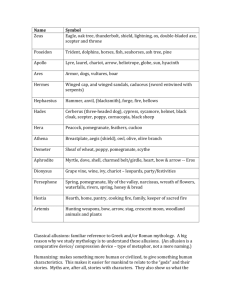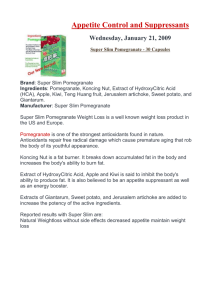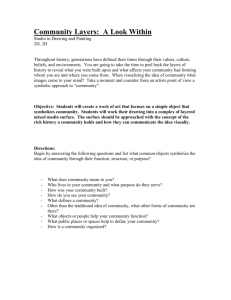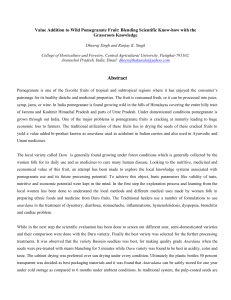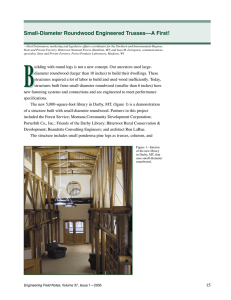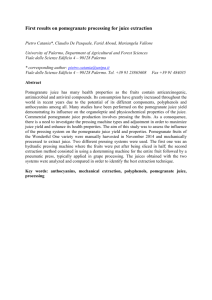Enclosure 4A - Project Summary Form
advertisement
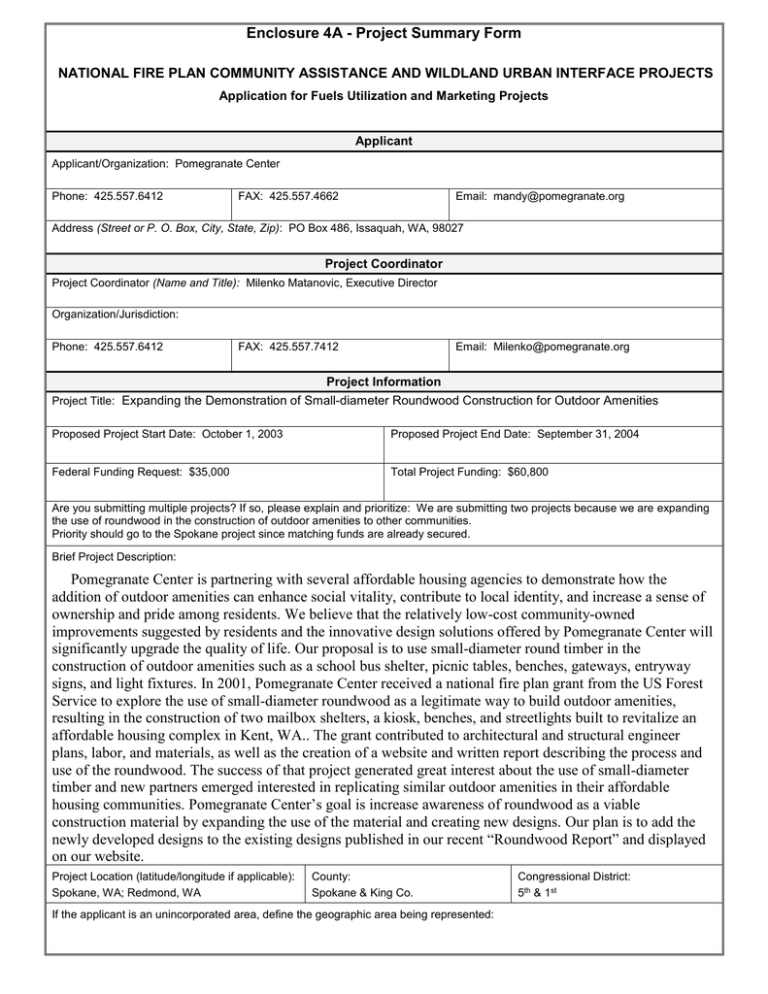
Enclosure 4A - Project Summary Form NATIONAL FIRE PLAN COMMUNITY ASSISTANCE AND WILDLAND URBAN INTERFACE PROJECTS Application for Fuels Utilization and Marketing Projects Applicant Applicant/Organization: Pomegranate Center Phone: 425.557.6412 FAX: 425.557.4662 Email: mandy@pomegranate.org Address (Street or P. O. Box, City, State, Zip): PO Box 486, Issaquah, WA, 98027 Project Coordinator Project Coordinator (Name and Title): Milenko Matanovic, Executive Director Organization/Jurisdiction: Phone: 425.557.6412 FAX: 425.557.7412 Email: Milenko@pomegranate.org Project Information Project Title: Expanding the Demonstration of Small-diameter Roundwood Construction for Outdoor Amenities Proposed Project Start Date: October 1, 2003 Proposed Project End Date: September 31, 2004 Federal Funding Request: $35,000 Total Project Funding: $60,800 Are you submitting multiple projects? If so, please explain and prioritize: We are submitting two projects because we are expanding the use of roundwood in the construction of outdoor amenities to other communities. Priority should go to the Spokane project since matching funds are already secured. Brief Project Description: Pomegranate Center is partnering with several affordable housing agencies to demonstrate how the addition of outdoor amenities can enhance social vitality, contribute to local identity, and increase a sense of ownership and pride among residents. We believe that the relatively low-cost community-owned improvements suggested by residents and the innovative design solutions offered by Pomegranate Center will significantly upgrade the quality of life. Our proposal is to use small-diameter round timber in the construction of outdoor amenities such as a school bus shelter, picnic tables, benches, gateways, entryway signs, and light fixtures. In 2001, Pomegranate Center received a national fire plan grant from the US Forest Service to explore the use of small-diameter roundwood as a legitimate way to build outdoor amenities, resulting in the construction of two mailbox shelters, a kiosk, benches, and streetlights built to revitalize an affordable housing complex in Kent, WA.. The grant contributed to architectural and structural engineer plans, labor, and materials, as well as the creation of a website and written report describing the process and use of the roundwood. The success of that project generated great interest about the use of small-diameter timber and new partners emerged interested in replicating similar outdoor amenities in their affordable housing communities. Pomegranate Center’s goal is increase awareness of roundwood as a viable construction material by expanding the use of the material and creating new designs. Our plan is to add the newly developed designs to the existing designs published in our recent “Roundwood Report” and displayed on our website. Project Location (latitude/longitude if applicable): Spokane, WA; Redmond, WA County: Spokane & King Co. If the applicant is an unincorporated area, define the geographic area being represented: Congressional District: 5th & 1st Enclosure 4B (Page 1 of 3) - Project Narrative Description Applications for funding must include a narrative response that describes the proposal. Please do not submit responses longer than one page, single space, 12-pitch font. Describe project including, but not limited to: project location Address these project implementation items as anticipated outcomes applicable: measures and reporting interagency partners project relationship to community or natural landscape fire plans. project time frames and income specify types of activities and equipment used amount or extent of actions (acres, number of homes, etc) environmental, cultural and historical resource requirements : Our proposal’s goal is to demonstrate the use of small-diameter timber as a sustainable building method for outdoor amenities. For over sixteen years Pomegranate Center has been working hand-in-hand with communities, businesses and individuals to promote a vision of inclusive, just, vibrant and environmentally-sound communities. Annually, over 5,000 individuals living in low-income, underserved, migrant or high-density communities benefit from our community building efforts. Pomegranate Center’s goal is to design and construct outdoor amenities out of small-diameter roundwood for two affordable housing complexes in Washington State. By using roundwood as the main building material, Pomegranate Center will be demonstrating a potential market for the material. Each project will have similar outdoor amenities: school bus shelters, benches, picnic tables, light fixtures, and gateways. However, each amenity will be designed and constructed reflecting the unique character of the community and natural landscape. Combined with our past experience with roundwood construction, these new designs will offer a broad range of design options for future partners interested in building outdoor amenities out of small-diameter timber. Partnering with the Spokane Neighborhood Action Program (SNAP) and the Sustainable Housing Innovation Partnership (SHIP), Pomegranate Center plans to develop cost-effective, beautiful and environmentally sustainable designs solutions to enhance the open spaces of a newly constructed 52-unit multi-family affordable housing complex in Spokane, Washington that incorporates sustainable design and resource efficient construction. Within this goal, Pomegranate Center’s objective is to create a central meeting/gathering place for the resident community which represents and embodies the purpose/mission of the project. Pomegranate Center believes the use of small-diameter roundwood captures this spirit. We have contacted Norgy Asleson with the Lakeface-Lamb Land Stewardship Contract, a wildland/urban interface and National Fire Plan project, to supply the small-diameter timber for the future amenities. With help from the local community, Pomegranate Center will begin developing the art-enhancing designs in Spring 2003. Construction is scheduled to begin this fall and will not be complete until June 2004. Pomegranate Center is also partnering with the Eastside Housing Association (EHA) and Leadership Institute to assist in the development of Avondale Park, a mixed-use urban community that provides both shelter and transitional housing along with community support, services, and social gathering spaces. Pomegranate Center’s vision is to use small-diameter timber to construct the outdoor amenities with the social gathering spaces. We are in the process of finalizing the site plans for the project. Once complete, Pomegranate Center will begin developing designs with construction scheduled to begin in June 2004. Pomegranate Center will evaluate the success of this project in the following ways: resident surveys at the end of the process will provide feedback on how much ownership community members felt through the process and final outcome, and whether or not they gained new skills through the process; participation lists will be kept to determine the level of volunteer support from within the community; regular site visits will allow Pomegranate Center to determine how the site is being used; local housing staff will be surveyed to receive their feedback on the success of the new space from the management and maintenance perspective; replication of our site-specific community-based designs by others in need of revitalizing/enhancing affordable housing complexes; and future partnerships with housing communities interested in constructing sustainable outdoor amenities. The core principles of these projects showcase how artistically designed amenities can be integrated into the everyday design of communities. Your grant of $35,000 would be used to develop architectural and structural engineering plans, document the projects success, produce educational materials, and purchase small-diameter lumber to construct school bus shelters, picnic tables, benches, gateways, and light fixtures. Response: Enclosure 4B (Page 2 of 3) - Project Evaluation Criteria Applications for funding must include narrative responses that address the following four criteria. Within each criterion, sub-criteria are listed in descending order of importance. Limit your responses to the areas provided. 1. Increasing Local Capacity (35 Points) A. How would the proposal improve or lead to the improvement of the local economy in terms of jobs and sustainable economic activity? How many jobs are expected to be created or retained and for how long (please distinguish between essentially yearround and seasonal jobs)? How will this proposal link to other projects (or proposed projects) to create year-round jobs? B. Will biomass or forest fuels be utilized; if so, in what manner and how much? C. Which, if any, private businesses will participate? D. To what extent will this project be offered to serve as a model for other communities or businesses, or natural landscapes? Response: As with all of Pomegranate Center’s projects, these two projects will involve residents in the design and construction phases, providing an opportunity for young and old alike to learn marketable skills by participating in the process. Detailed meeting minutes and lists of participants to show attendance and participation levels will be kept. Resident surveys at the end of the process will provide feedback on whether or not participants gained new skills through the process. We anticipate employing two construction/carpenters, an architect, engineer, artist, and project manager. Each outdoor amenity will be designed entirely out of roundwood. In a former project, Pomegranate Center built two mailbox shelters, a kiosk, benches, and two streetlights out of 2100 bf of small-diameter timber harvested from a SmartWood tree farm. The overall design will determine the amount of roundwood used. An important benefit of this project will be to showcase various applications of round timber in structuremaking and highlight the relevance of building choices and materials to environmental realities. We see the collaboration of housing revitalization efforts with sustainable building techniques to have far-reaching potential. Should these projects find appropriate funding, Pomegranate Center will have successfully constructed three outdoor amenity projects using roundwood. We plan to continue expanding on these successes and increase the visibility by developing educational materials, significantly enhancing the awareness of small-diameter timber locally and regionally. 2. Reducing fire risk. (30 points) Describe how the proposal promotes reduction of risk in high hazard areas and communities or natural landscapes. Describe how the proposed project benefits resources on federal land or adjacent non-federal land, or how it protects the safety of communities. C. To what extent does the project implement or create a cooperative (1) fuels treatment plan or (2)community fire strategy (include evidence of the plan if it already exists)? D. Explain how the proposal (1) leads to, enhances or restores a local fire-adapted ecosystem, and/or (2) mitigates or leads to the mitigation of hazardous fuels conditions. A. B. Response: By partnering with the Lakeface-Lamb Land Stewardship Contract, Pomegranate is contributing to the reduction of forest fuels by utilizing the use of small-diameter lumber in the creation of outdoor amenities. These projects will help reduce fire risk indirectly by promoting the economic viability of harvesting round, small-diameter timber as a viable construction material. It focuses on end-use applications, public awareness, and future markets. In this way, the project addresses the problem of wildfires in our secondary growth forests over a longer term, recognizing that the state of health of our forests will need attention for many years. It offers a way to harness an available and plentiful resource for needed construction while mitigating fire risk. Enclosure 4B (Page 3 of 3) - Project Evaluation Criteria 3. Expanding Community Participation. (15 Points) A. To what extent have interested individuals, groups, and communities been provided an opportunity to become informed and involved in this proposal? B. Describe the extent of local support or opposition for the project, including any cost-sharing arrangements C. What are the environmental, social and educational benefits or concerns of the project? Response: All partners (SNAP, SHIP, EHA, and Leadership Institute) are committed to developing sustainable outdoor amenities for their affordable housing complexes and each has adopted the concept of using smalldiameter roundwood in the construction. SNAP and SHIP have agreed to fund the creation and installation of the picnic tables and benches. Members of the Leadership Institute will be providing coordination services. Other support is being pursued, including in-kind donations of equipment and labor. Pomegranate Center’s projects typically benefit from 1000-1500 volunteer hours, resulting in greater ownership and stewardship of the amenities. We hope to leverage support from the US Forest Service to help secure additional funds. The main benefit of these projects will be in showcasing the many applications of round timber and educating others in its uses. Our hope is that these projects will not only be a model for sustainable communities but will also encourage the use of sustainable, innovative building techniques in future projects. 4. Increasing interagency and intergovernmental coordination. (20 Points) A. Explain the level of cooperation, coordination or strategic planning through a “Local Coordination Group” for wildland fire activities, or among federal, state, tribal, local government and community organizations in developing this proposal. List the cooperators (a detailed list of cooperators will be required for projects that are funded). B. Describe how this project implements a local intergovernmental strategy or plan, or creates such a plan. Describe the plan if it already exists. Response: Partners include the Spokane Neighborhood Action Program, Sustainable Housing Innovative Partnership, Eastside Housing Association, Hopelink, Friends of Youth, and Leadership Institute. Expertise from each of these agencies has been included in the project planning thus far, and will be included in the future. It is our hope that coordination with the Lakeface-Lamb Stewardship Contract will lead to additional partnerships with agencies interested in reducing biomass and forest fuels while profiting from the sales of the lumber for commercial production. The success of these projects will promote similar future projects. Enclosure 4C - Project Work Form Tasks Time Frame Responsible Party Design of Structures for Sustainable Housing Innovation Partnership (SHIP) in Spokane, WA Summer & Fall 2003 Pomegranate Center + design professionals Recruit community volunteers; construct structures for SHIP October 2003 Pomegranate Center; SHIP Design Structures for Eastside Housing Association (EHA) in Redmond, WA Spring 2003 Pomegranate Center + design professionals Recruit community volunteers; construct structures for EHA Summer 2004 Pomegranate Center + EHA Document process/update website October 2003-September 2004 Pomegranate Center Public presentation(s) Ongoing Pomegranate Center + associated partners Enclosure 4D - Project Budget Cost Category Description Personnel Federal Agency Applicant Partner 1 Partner 2 Total $10,500 $22,800 $250 $900 $1,150 $700 $100 $800 $16,500 $4,300 $20,800 $7,950 $4,100 $9,600 $2,700 Subtotal Fringe Benefits Subtotal Travel Subtotal Equipment Subtotal Supplies Subtotal Contractual $3,200 $15,250 Subtotal Other $0 Subtotal Total Costs $35,000 $2,700 $19,900 $3,200 Project (Program) Income1 1 Program income is the gross revenue generated by a grant or cooperative agreement supported activity during the life of the grant. Program income can be made by recipients from fees charged for conference or workshop attendance, from rental fees earned from renting out real property or equipment acquired with grant or cooperative agreement funds, or from the sale of commodities or items developed under the grant or cooperative agreement. The use of Program Income during the project period may require prior approval by the granting agency. $60,800 $0
